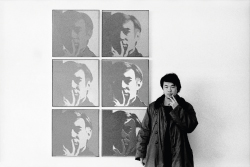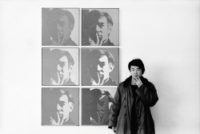Press Release Andy Warhol | Ai Weiwei Opens at The Andy Warhol Museum June 4, 2016

Ai Weiwei, At the Museum of Modern Art, 1987, From the New York Photographs series 1983–93, Collection of Ai Weiwei, © Ai Weiwei; Andy Warhol artwork © The Andy Warhol Foundation for the Visual Arts, Inc.
For immediate release
Tuesday, March 8, 2016
Andy Warhol | Ai Weiwei
June 4–August 28, 2016
The Andy Warhol Museum opens a major international exhibition featuring two significant artists of the 20th and 21st centuries—Andy Warhol and Ai Weiwei— June 4, 2016. The exhibition opened at the National Gallery of Victoria (NGV) in Melbourne, Australia, on December 11, 2015, to record-breaking attendance.
Andy Warhol | Ai Weiwei, developed by The Warhol and the NGV, with the participation of Ai Weiwei, explores the significant influence of these two artists on modern and contemporary life, focusing on the parallels, intersections, and points of difference between their practices—Warhol representing 20th-century modernity and the “American century,” and Ai representing life in the 21st century and what has been called the “Chinese century” to come.
“This project is perhaps the most important exhibition The Warhol has ever taken on. No two artists changed—or in the case of Ai Weiwei, is changing—the very fabric of his time and place more than Andy Warhol and Ai Weiwei,” says The Warhol’s Director Eric Shiner. “Both artists call into question what art can and should be, and both overcame nearly invincible odds to rise to the top of the art world thanks to their creative rebellion. We are honored to bring them together here in Pittsburgh.”
Each artist is recognized for his distinctive approach to ideas of artistic value and studio production. Warhol’s Factory was known for its experimentation and inclusivity, bringing together artists and poets, film-makers and musicians, bohemians and intellectuals, as well as for the serial production of silkscreen paintings, films, television, music, and publishing.
Ai’s studio is renowned for its interdisciplinary approach, post-industrial modes of production, engagement with teams of assistants and collaborators, and strategic use of communications technology and social media. Both artists have been equally critical in redefining the role of the artist and are known for their observation and documentation of contemporary society and everyday life.
At The Warhol, the exhibition creates a dialogue between the artists, throughout the seven floors of the building. Warhol and Ai share a capacity to engage a multitude of media, using it as a means to become acute observers of contemporary culture and politics. Visitors experience more than 350 works in drawing, film, new media, photography, painting, sculpture, wallpapers, and publishing, including some of the major contributions by both artists, each of whom is as famous for his artistic persona as for the work he produced.
Repetition and the readymade are important to both artists’ practices, and Marcel Duchamp’s influence is explored though the association of such works as Warhol’s Brillo Boxes (1964) and Ai’s Tea Brick (2006). Surveillance and the state is a prominent theme, revealed in Warhol’s Little Electric Chair (1964–65) and Ai’s marble Surveillance Camera (2010), portraits from Warhol’s Most Wanted Men series (1964), and Ai’s Study of perspective series (1995–2003), in which the artist makes provocative gestures at state monuments, situated among other works with similar themes.
A more playful side of the artists is discovered through their shared appreciation for cats—Warhol’s 1950s cat drawings appear alongside photographs of the artist and his cat—and they play an important role in both artists’ practices. Additional dialogues are created with the artists’ photographs, early drawings, works exploring ideas of glamour and beauty, and the use of flowers in both artists’ work.
The moving image is also important to the artistic practices of both artists. Warhol, famously interested in extended duration, turned his camera on New York City icon The Empire State Building in his eight-hour film Empire (1964). Ai chose to focus on Beijing’s celebrated ring roads as well as the Chang’an Jie, or the Avenue of Eternal Peace, which cuts across the roads through the heart of the city, Tiananmen
Square. The exhibition includes Ai’s 10-hour video Chang’an Boulevard (2004), as well as his shorter recordings Beijing: The Second Ring (2005) and Beijing: The Third Ring (2005). His music video Dumbass (2013) is also shown.
An exhibition catalogue, Andy Warhol | Ai Weiwei, published by the NGV, in collaboration with The Warhol and Ai, and edited by Eric Shiner, The Warhol’s director, and Max Delany, former NGV senior curator, contemporary art, accompanies the exhibition. Alongside reproduced images by both artists are essays by an international team of art experts, curators, and scholars that survey the scope of the artists’ careers and interpret the impact of Warhol and Ai on contemporary art and life. This publication is the first to explore the significant influence of these two artists. The catalogue is available for purchase in The Warhol Store.
Andy Warhol (Pittsburgh, 1928–New York, 1987) was a leading protagonist in the development of Pop Art, and his influence extended beyond the world of fine art and into music, film, television, celebrity, publishing, and popular culture. Warhol created defining iconography of the late 20th century through his exploration of consumer society, fame and celebrity, media, advertising, politics, and capital.
Ai Weiwei (Beijing 1957– ) is an artist and social activist working in China and Berlin. His work encompasses diverse fields including visual art, architecture, publishing and curatorial practice, cultural criticism, social media, and activism, and he is currently deeply engaged with the refugee crisis in Europe. Ai’s work addresses some of the most critical global issues of the early 21st century, including the relationship between tradition and modernity, the role of the individual and the state, questions of human rights, and the value of freedom of expression.
ACCOMPANYING INSTALLATION
Circle of Animals / Zodiac Heads
May 28–August 29, 2016
Carnegie Museum of Art (Oakland)
In conjunction with Andy Warhol | Ai Weiwei at The Warhol, Ai’s Circle of Animals / Zodiac Heads (2011) is on display at Carnegie Museum of Art in the Hall of Architecture May 28–August 29, 2016. The artwork is made up of 12 bronze animal heads representing the traditional Chinese zodiac that once adorned the famed fountain-clock of Yuanming Yuan, an imperial retreat in Beijing destroyed by the British in 1860. Each figure stands nearly 10 feet tall and weighs approximately 1,000 pounds. The artwork is a reproduction reflecting on the original looted artworks, questioning looting and repatriation and exploring ideas of the copy in relation to the original.
The Hall of Architecture houses one of the world’s few remaining plaster cast collections, filled with reproductions of colossal building facades and fragments from ancient times to the Renaissance. Circle of Animals / Zodiac Heads likewise deals with architectural fragments. It pays homage to China’s history while speaking to contemporary concerns, considering notions of reproduction in order to bring to life the original looted artworks.
The Warhol is working in collaboration with Pittsburgh Cultural Trust’s Three Rivers Arts Festival, City of Asylum, and the Asian Studies Center, University Center for International Studies at the University of Pittsburgh.
Exhibition-related public programs, including an opening celebration, gallery talks, and education initiatives, will be announced at a later date.
Andy Warhol | Ai Weiwei is supported in part by an award from the National Endowment for the Arts, The Fine Foundation, and The Heinz Endowments, with additional support from Christopher Tsai and André Stockamp.
The Warhol receives state arts funding support through a grant from the Pennsylvania Council on the Arts, a state agency funded by the Commonwealth of Pennsylvania; the National Endowment for the Arts, a federal agency; and The Heinz Endowments. Further support is provided by the Allegheny Regional Asset District.
The Andy Warhol Museum
Located in Pittsburgh, Pennsylvania, the place of Andy Warhol’s birth, The Andy Warhol Museum holds the largest collection of Warhol’s artworks and archival materials and is one of the most comprehensive single-artist museums in the world. The Warhol is one of the four Carnegie Museums of Pittsburgh.
Carnegie Museums of Pittsburgh
Established in 1895 by Andrew Carnegie, Carnegie Museums of Pittsburgh is a collection of four distinctive museums: Carnegie Museum of Art, Carnegie Museum of Natural History, Carnegie Science Center, and The Andy Warhol Museum. The museums reach more than 1.4 million people a year through exhibitions, educational programs, outreach activities, and special events.
Press Images
By downloading images, you are agreeing to use them for non-commercial, editorial press coverage only, and reproduce each with its accompanying credit and copyright. Please see full terms of service.
Credit and copyright
Ai Weiwei, At the Museum of Modern Art, 1987, From the New York Photographs series 1983–93, Collection of Ai Weiwei, © Ai Weiwei; Andy Warhol artwork © The Andy Warhol Foundation for the Visual Arts, Inc.
Downloads

Ai Weiwei, At the Museum of Modern Art, 1987, From the New York Photographs series 1983–93, Collection of Ai Weiwei, © Ai Weiwei; Andy Warhol artwork © The Andy Warhol Foundation for the Visual Arts, Inc.